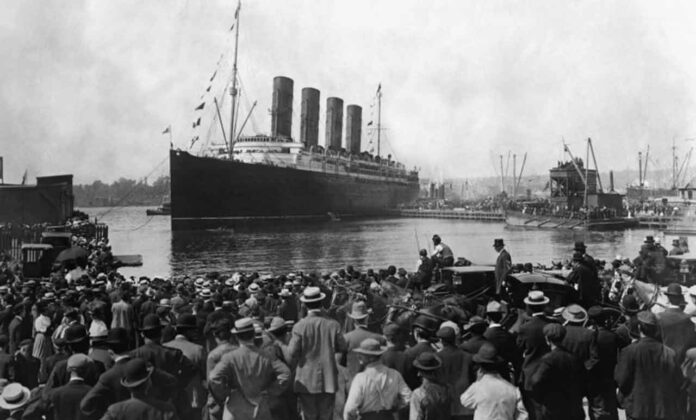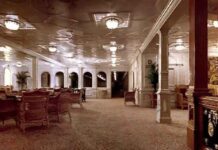From Heiresses to Industrialists, the World’s Most Influential Citizens Sail Together on a Floating Palace
ABOARD RMS TITANIC, April 11, 1912 — As the RMS Titanic steams westward through the Atlantic, there is no shortage of fine conversation and finer company aboard what is undoubtedly the most luxurious vessel ever built. Now several days into her maiden voyage, the ship has become a microcosm of high society — a place where fortunes walk the corridors, and influence dines beneath cut-glass chandeliers.
In our coverage of the RMS Titanic Anniversary this year, NetNewsLedger will cover the event as if we were covering it as it happened. This first report as the ship prepares to set course on her fateful journey is on the days before sailing. In those days newspaper coverage was the premier media.
Among the First Class passengers are names well known in salons from London to Newport, men and women whose wealth and bearing place them among the elite of their time. In the saloons and promenades of this floating metropolis, one may glimpse the captains of industry, the doyennes of fashion, and those whose names are spoken in drawing rooms across two continents.
A STROLL THROUGH HIGH SOCIETY
The most talked-about couple aboard is undoubtedly Colonel John Jacob Astor IV, 47, and his young bride, Madeleine, just 19. Colonel Astor, heir to one of America’s greatest fortunes, is known for his inventions, real estate acumen, and service during the Spanish-American War. The newlyweds, returning from a honeymoon abroad, are often seen walking the deck arm in arm, the Colonel attentive, the young Mrs. Astor wrapped in the latest Parisian fashions.
Another figure of great interest is Mr. Benjamin Guggenheim, of the famed mining dynasty. Known for his wealth and continental sensibilities, Mr. Guggenheim is traveling with his valet and secretary, and has brought aboard a wardrobe to rival any nobleman.
Also aboard is Mr. Isidor Straus, co-owner of Macy’s Department Store, and a former member of the U.S. Congress. With him is his devoted wife, Ida, their bond said to be as admired as their philanthropic work. The pair rarely leaves each other’s side.
At dinner, one may overhear lively discussions between Mr. George Widener, of the Pennsylvania streetcar empire, and Major Archibald Butt, military aide to President Taft, whose bearing is as straight as his uniform is immaculate.
THE UNEXPECTED SOCIETY STAR
One woman turning heads and winning hearts aboard is Mrs. Margaret Brown of Denver — known simply as “Maggie” to friends. A self-made woman of considerable means thanks to mining interests in Colorado, Mrs. Brown is a keen conversationalist, fluent in French, and possessed of a quick wit. She has already organized an impromptu reading for charity in the first-class lounge and is said to be an excellent card player.
Though not a blueblood by birth, Mrs. Brown’s confidence and compassion make her as welcome among the Astors and Guggenheims as any duchess.
SYMBOLS OF THE MODERN WORLD
These passengers are more than mere socialites — they are avatars of the modern age. In their pursuits and personalities, they represent the great transitions of our time: from inherited aristocracy to industrious wealth, from old Europe to new America.
Together aboard the Titanic, they exemplify the spirit of the Edwardian world — refined, ambitious, and seemingly invincible. As they take tea in the Palm Court or dance to the strains of Wallace Hartley’s orchestra, one cannot help but feel that they, like the ship they sail upon, are forging a new future — sleek, steel-bound, and luminous with promise.
A VOYAGE TO BE REMEMBERED
Though the sea remains calm and the days pass in elegance and ease, many passengers agree that this is no ordinary crossing. With its blend of opulence and innovation, Titanic has created something rare: a shared stage upon which the leaders of a changing world may meet, if only briefly.
What stories will they tell of this voyage? What friendships may be kindled beneath the North Atlantic sky? Only time will tell.



